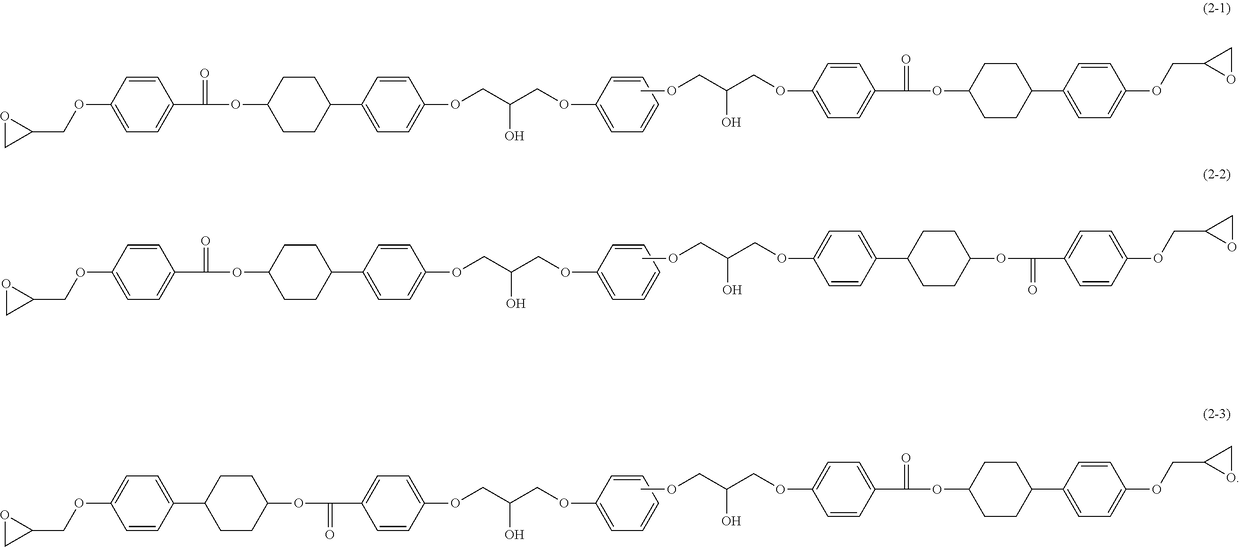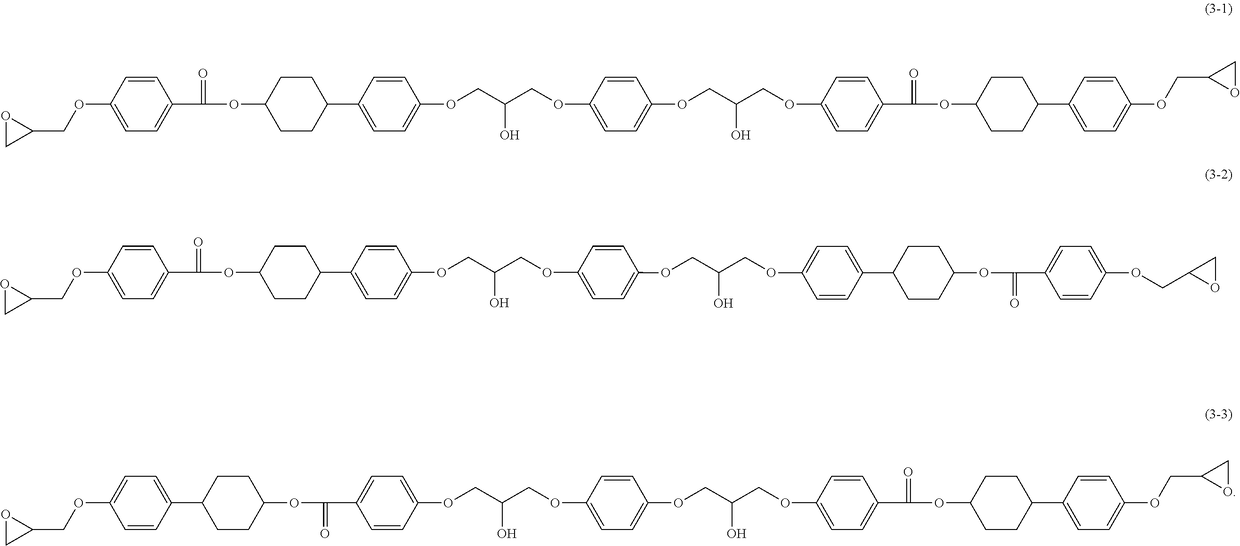Epoxy resin, epoxy resin composition, inorganic filler-containing epoxy resin composition, resin sheet, cured product, and epoxy compound
- Summary
- Abstract
- Description
- Claims
- Application Information
AI Technical Summary
Benefits of technology
Problems solved by technology
Method used
Image
Examples
example 1
[Synthesis of Epoxy Resin]
[0216]Epoxy resin monomer 1 (ME21) (50 g (0.118 mol)) was weighed and loaded into a 500-mL three-necked flask, and 80 g of synthesis solvent 1 (cyclohexanone) was added thereto. The three-necked flask was attached with a cooling tube and a nitrogen introduction tube, and a stirring blade was installed thereinto so as to be immersed in the solvent. The three-necked flask was immersed in an oil bath at 160° C., and stirring was initiated. After it was confirmed that epoxy resin monomer 1 was dissolved and a clear solution was obtained after several minutes, 0.91 g (0.0083 mol) of phenol compound 1 (hydroquinone) was added into the flask, 0.5 g of curing catalyst 1 (triphenyl phosphine) was further added thereto, and the resultant was continuously heated at an oil bath temperature of 160° C. After heating was continued for 5 hours, the residue obtained by distilling off cyclohexanone from the reaction solution under reduced pressure was cooled to room temperat...
example 2
[Synthesis of Epoxy Resin]
[0230]Epoxy resin 2 was obtained in the same manner as in Example 1 except that the amount of phenol compound 1 (hydroquinone) to be added was changed to 1.3 g (0.0118 mol). Epoxy resin 2 included a part of the synthesis solvent, and the unreacted epoxy resin monomer.
[0231]The solid content of epoxy resin 2 was measured by a heating loss method, and was 96.3%.
[0232]The number average molecular weight of epoxy resin 2 was measured by gel permeation chromatography (GPC), and the number average molecular weight of a polymer component newly produced by the synthesis was 1,315, and the number average molecular weight of a portion including the unreacted epoxy resin monomer was 531.
[0233]The epoxy equivalent of epoxy resin 2 was measured by a perchloric acid titration method, and was 256 g / eq.
[0234]The softening temperature of epoxy resin 2 was measured by a ring-and-ball method, and was from 75° C. to 80° C.
[0235]The temperature at which transition from a crysta...
example 3
[Synthesis of Epoxy Resin]
[0243]Epoxy resin 3 was obtained in the same manner as in Example 1 except that the amount of phenol compound 1 (hydroquinone) to be added was changed to 1.95 g (0.0176 mol). Epoxy resin 3 included a part of the synthesis solvent, and the unreacted epoxy resin monomer.
[0244]The solid content of epoxy resin 3 was measured by a heating loss method, and was 97.1%.
[0245]The number average molecular weight of epoxy resin 3 was measured by gel permeation chromatography (GPC), and the number average molecular weight of a polymer component newly produced by the synthesis was 1,520, and the number average molecular weight of a portion including the unreacted epoxy resin monomer was 583.
[0246]The epoxy equivalent of epoxy resin 3 was measured by a perchloric acid titration method, and was 263 g / eq.
[0247]The softening temperature of epoxy resin 3 was measured by a ring-and-ball method, and was from 30° C. to 35° C.
[0248]The temperature at which transition from a cryst...
PUM
| Property | Measurement | Unit |
|---|---|---|
| Temperature | aaaaa | aaaaa |
| Power | aaaaa | aaaaa |
| Angle | aaaaa | aaaaa |
Abstract
Description
Claims
Application Information
 Login to View More
Login to View More - R&D
- Intellectual Property
- Life Sciences
- Materials
- Tech Scout
- Unparalleled Data Quality
- Higher Quality Content
- 60% Fewer Hallucinations
Browse by: Latest US Patents, China's latest patents, Technical Efficacy Thesaurus, Application Domain, Technology Topic, Popular Technical Reports.
© 2025 PatSnap. All rights reserved.Legal|Privacy policy|Modern Slavery Act Transparency Statement|Sitemap|About US| Contact US: help@patsnap.com



